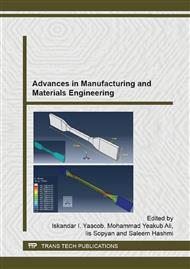[1]
Wad, P., The automobile industry of Southeast Asia: Malaysia and Thailand. Journal of the Asia Pacific Economy, 2009. 14(2): pp.172-193.
DOI: 10.1080/13547860902786029
Google Scholar
[2]
Holweg, M., The evolution of competition in the automotive industry. In Build To Order. Springer London, (2008).
Google Scholar
[3]
Womack, James P., Daniel T. Jones, and Daniel Roos, The machine that changed the world. Simon and Schuster, (2008).
Google Scholar
[4]
Holweg, M., The genealogy of lean production. Journal of Operations Management, 2007. 25(2): pp.420-437.
Google Scholar
[5]
Sabuncuoglu, I., Erel, E., & Tanyer, M., Assembly line balancing using genetic algorithms. Journal of Intelligent Manufacturing, 2000. 11 (3): pp.295-310.
DOI: 10.1023/a:1008923410076
Google Scholar
[6]
Fattahi, P., Roshani, A., & Roshani, A., A mathematical model and ant colony algorithm for multi-manned assembly line balancing problem. The International Journal of Advanced Manufacturing Technology, 2011. 53(1-4): pp.363-378.
DOI: 10.1007/s00170-010-2832-y
Google Scholar
[7]
H. M. Emrul Kays, A. N. M. Karim, M. Abdesselam, Muataz H.F. Al Hazza, R. A. Sarker, Formulation of Integer Programming Model for Balancing and Scheduling of Production Line Having Shared Resources. Proceedings of the 2014 International Conference on Industrial Engineering and Operations Management, Bali, Indonesia, 2014. p.1998-(2007).
Google Scholar
[8]
Miltenburg, J., Balancing and scheduling mixed-model U-shaped production lines. International Journal of Flexible Manufacturing Systems, 2002. 14(2): pp.119-151.
Google Scholar
[9]
Mahadevan, B., Operations Management: Theory and Practice. Pearson Education India, (2010).
Google Scholar
[10]
Helgeson, W.R. and Birnie, D.P. , Assembly line balancing using the ranked positional weight technique. Journal of Industrial Engineering, 1961. 12: pp.394-398.
Google Scholar
[11]
Ağpak, K., & Gökçen, H., Assembly line balancing: Two resource constrained cases. International Journal of Production Economics, 2005. 96(1): pp.129-140.
DOI: 10.1016/j.ijpe.2004.03.008
Google Scholar
[12]
Kao, H. H., Yeh, D. H., & Wang, Y. H. Resource Constrained Assembly Line Balancing Problem Solved with Ranked Positional Weight Rule. Review of Economics & Finance, 2011. 1: pp.71-80.
Google Scholar
[13]
Tuncel, G., & Topaloglu, S., Assembly line balancing with positional constraints, task assignment restrictions and station paralleling: A case in an electronics company. Computers & Industrial Engineering, 2013. 64(2): pp.602-609.
DOI: 10.1016/j.cie.2012.11.006
Google Scholar


